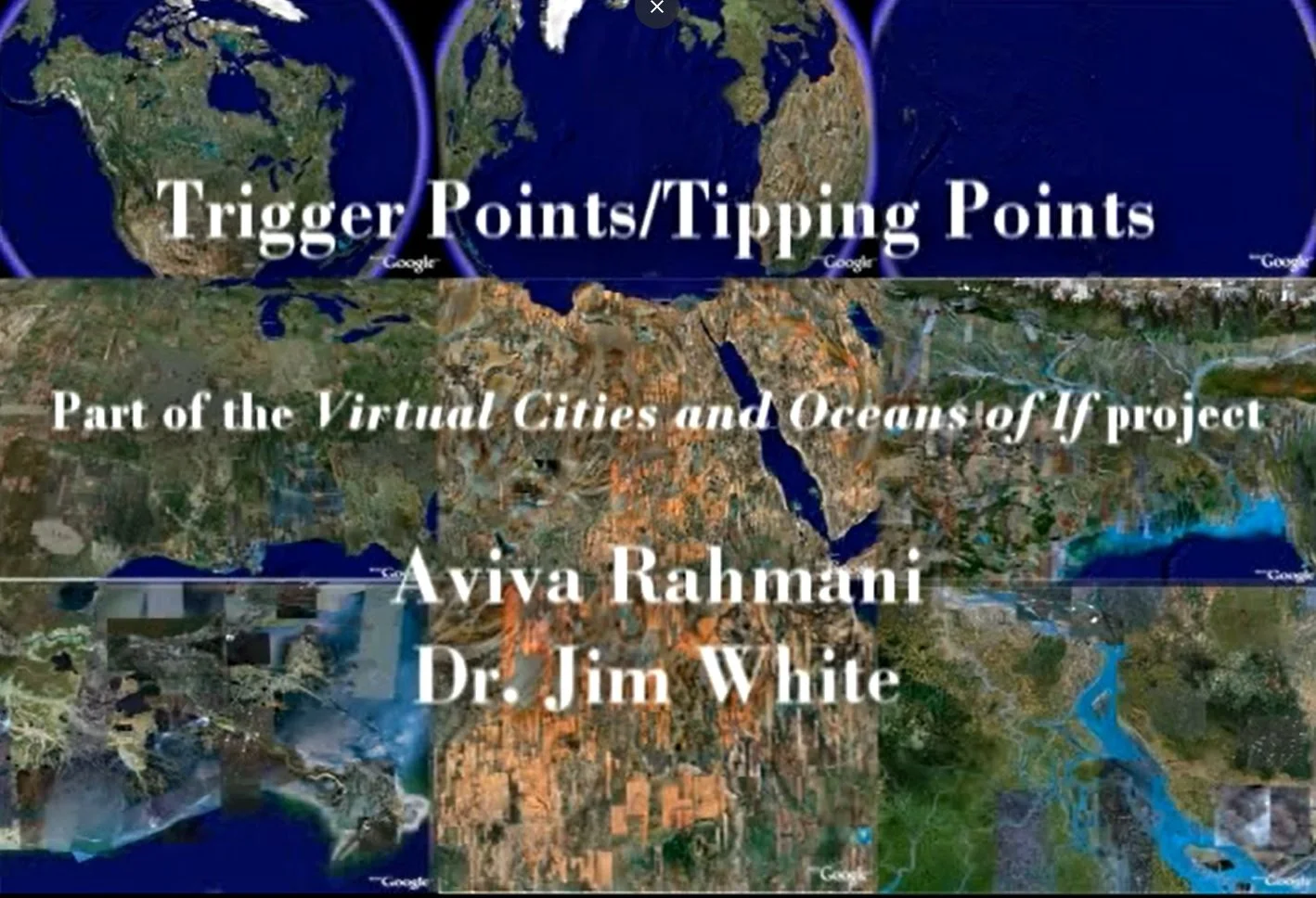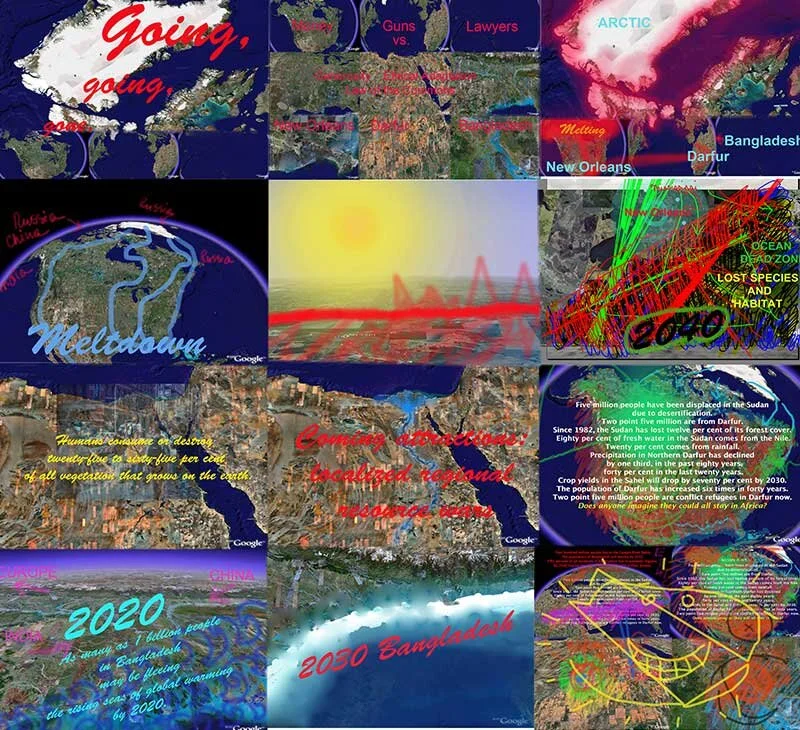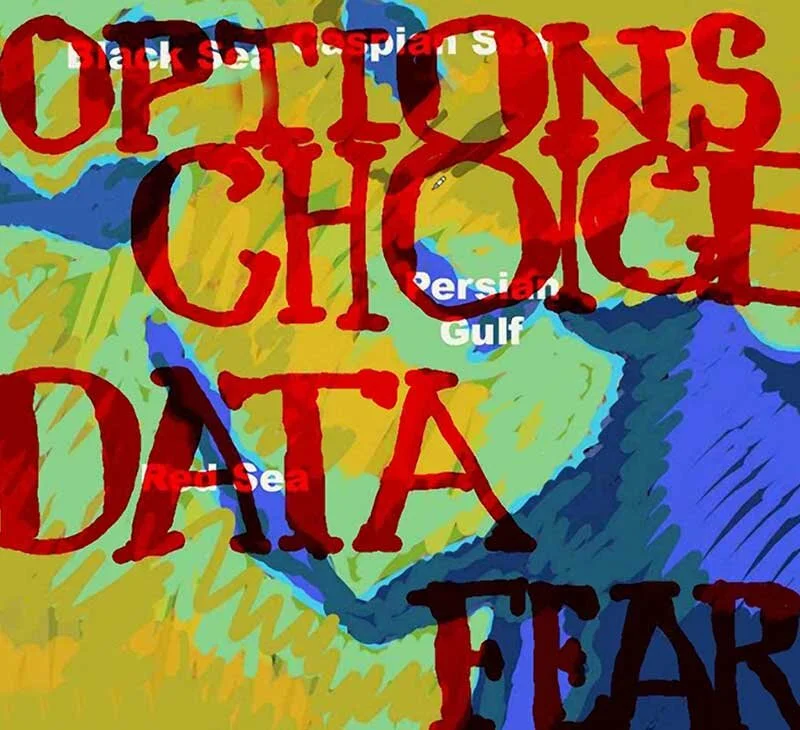“we don’t need hope, we need (your) honesty”
Spencer Koonin and Mae Kennedy, President/Vice President of the Princeton Conservation Society, 2022, upon the occasion of Aviva Rahmani’s talk and trigger point workshop at Princeton University October 4, 2022.
Climate Change / Global Warming
Aviva Rahmani has been concerned about climate change throughout her career. In Ghost Nets, she experimented with planting vegetation for a more temperate climate, such as Magnolia grandiflora, to track how well they would flourish as the site warmed with the rest of the planet. Her concern with climate change went to the top of her priorities in 2005 after the dramatic catastrophe of Hurricane Katrina.
Trigger Points/Tipping Points
Trigger Points / Tipping Points is a series of works developed out of a collaboration with scientist Dr. Jim White. The project consisted of a series of computer images that assembled and manipulated satellite images to predict and speculate on the relationships between the impacts of global warming on major river deltas that were also the sites of conflict zones, such as the Ganges, the Nile, and the Mississippi River.
Trigger Points / Tipping Points, a work by Aviva Rahmani and paleoecologist Dr. Jim White of the Institute for Arctic and Alpine Research (INSTAAR) at the University of Colorado in Boulder, where Rahmani is an affiliate, was initiated in 2007 by Marda Kirn of EcoArts Connections (EAC). Kirn asked Lucy Lippard to curate an exhibition, pairing a number of artists and scientists to collaborate on a project called Weather Report: Art and Climate Change, co-produced by EAC and Boulder Museum of Contemporary Art in Boulder, Colorado. Trigger Points / Tipping Points premiered at the 2007 Venice Biennale and was subsequently shown at additional international venues, including sites in New York City and in Russia.
The topic over six months of regular desktop-sharing sessions was the impact of global warming on conflict zones around the world in relation to river systems, such as, Bangladesh and the Ganges; Darfur and the Nile; and New Orleans and the Mississippi. Installation stills and a 20-minute video were generated from the desktop-sharing webcasts.
Trigger Points Tipping Points Grid Date: 2007 Size: 47" x 52" Materials: Grid of digitized prints on archival paper Description: Installallation of screen capture stills generated live during desktop sharing sessions with Dr. Jim White, for the Weather Report Show curated by Lucy Lippard for the Boulder Museum of Contemporary Art, Boulder, Colorado.
Mississippi 2040 detail of Trigger Points/ Tipping Points installation Date: 2007 Size: 13" x 19" Materials: digitized print on archival paper Description: Still created in collaboration with Dr. Jim White, for the 2007 Weather Report show, curated by Lucy Lippard for the Boulder Museum of Contemporary Art, Boulder, Colorado.
New Orleans in Gulf of Mexico detail of Trigger Points/ Tipping Points Installation Date: 2007 Size: 13" x 19" Materials: digitized print on archival paper Description: Still created in collaboration with Dr. Jim White, for the 2007 Weather Report show, curated by Lucy Lippard for the Boulder Museum of Contemporary Art, Boulder, Colorado.
Bangladesh Ganges Erased detail of Trigger Points/ Tipping Points Installation Date: 2007 Size: 13" x 19" Materials: digitized print on archival paper Description: Still created in collaboration with Dr. Jim White, for the 2007 Weather Report show, curated by Lucy Lippard for the Boulder Museum of Contemporary Art, Boulder, Colorado.
Provenance:
Stills from Trigger Points/Tipping Points have been shown in the following exhibitions: Weather Report, curated by Lucy Lippard, Boulder Museum of Contemporary Art, Boulder, CO, September 14 - December 12, 2007; The Cultura21 Group at the Joseph Beuys 100 days of Conference Pavilion, Venice Biennale, Venice, Italy, September 6, 2007; Feeling the Heat, curated Liz Christensen, Deutsche Bank Art Gallery, New York City, NY, June, 2008; In Transition Russia 2008, curated by Sheila Pinkel, The Independent Museum of Contemporary Art (IMCA), Cyprus and NeMe in collaboration with the National Centres of Contemporary Art (NCCA), Ekaterinburg and Moscow, Russian Federation and Climate Change: Conveying Realities curated by Chris Cuomo, eco*art*lab, Athens GA, March 23 - April 27, 2013.
Publications:
Dederer, Claire. "Looking for Inspiration in the Melting Ice." Sunday Arts & Leisure, New York Times September 23, 2007.
Lippard, Lucy. Weather Report. Boulder Museum of Contemporary Art, Boulder Colorado, 2007.
Black, Helene and Pinkel, Sheila. In Transition Russia 2008. Presented by NeMe, 2008.
Boettger, Suzaan. "Global Warnings." Art in America, illustrated page 161, discussed page 206, June/July 2008.
Boettger, Suzaan. "Global Warnings." Art in America, illustrated page 161, discussed page 206, June/July 2008.
Gulf to Gulf
Gulf to Gulf engages artists and scientists in an ongoing mini think tank style research project and conversation on global warming in gulf regions, and how art can affect climate policy. Centrally a collaboration and ongoing series of webcast conversations between Aviva, Dr. Jim White, and Dr. Eugene Turner, the project has grown a collection of raw recordings of webcast conversations, including international guest artists and scientists, and has been accessed across eighty-five countries.
Gulf to Gulf began in 2009 as a project sponsored by the New York Foundation for the Arts. The focus of Gulf to Gulf is to effect climate-change policy with art, while observing the impacts of global warming on gulf regions internationally. Work includes site observation, interactive desktop sharing sessions, in webcasts with scientists and others led by Aviva Rahmani. The Blued Trees Symphony is part of Gulf to Gulf.
Documentation, analysis, and interpretation of new insights about climate change and global warming are presented in informal conversations between Aviva Rahmani and Dr. Jim White, paleoecologist (professor of geological sciences, fellow and director of the Institute for Arctic and Alpine Research, INSTAAR, at the University of Colorado at Boulder); Dr. Eugene Turner, wetlands biologist (distinguished research master and professor, Department of Oceanography and Coastal Sciences, Louisiana State University, Baton Rouge); and invited guests. Gulf to Gulf partners with WebServes (James Bradley)—developers of the Gulf to Gulf Project website—to broadly reconceive the definition of a site as geographic location and virtual interface. It presumes that physical, imaginative, and virtual sites can be interdependent.
The target of these conversations is climate change policy. Gulf to Gulf, a collection of raw recordings of webcast conversations, has been accessed from over eighty-five countries, and has a dedicated website. Guests have included the late Dr. Michele Dionne, former director of research at the Wells National Estuarine Research Reserve, Wells, Maine; Dr. Thomas Dunlap, environmental historian, professor at Texas A & M University; the philosopher Baird Callicott and Dr. Harvey Hix, an American poet, scholar, and professor at the University of Wyoming.
Gulf to Gulf builds on the previous Virtual Concerts format of free-flowing podcast discussions.
Red Sky Date: 2009 Size: Variable Materials: Digital photograph with Photoshop Description: Image captured from moving train in the Louisiana Bayous during hurricane season 2009, and later photoshopped.
Persian Gulf Date: 2009 Size: Variable Materials: digital drawing with Photoshop Description: Screen capture of still generated live during Gulf to Gulf desktop sharing sessions with a team of scientists and others.
Do Something Date: 2009 Size: Variable Materials: digital drawing with Photoshop Description: Screen capture of still generated live during Gulf to Gulf desktop sharing sessions with a team of scientists and others.
Options Data Choice Date: 2009 Size: Variable Materials: digital drawing with Photoshop Description: Screen capture of still generated live during Gulf to Gulf desktop sharing sessions with a team of scientists and others.
Provenance:
Stills from Gulf to Gulf were shown in the following exhibition: Still Waters, curated by Lisa Alembik, Dalton Gallery, Agnes Scott College Decatur, GA, 2009.
Publications:
Carpenter, Lucas. “Review of Still Waters Show,” Art Papers p. 50, January/February 2010.
Redelius, Gunilla. “Aviva Rahmani Projects” LabforCulture.org http://www.labforculture.org/en/home/contents/climate-change-artists-respond/artistic-projects/aviva-rahmani-projects posted November 16th 2010.
Felde, Lena. “Gulf to Gulf Talk Online,” Cultura21 posting on the CSPA website http://www.sustainablepractice.org/2014/10/04/gulf-to-gulf-talk-online/ Posted September 21, 2014.










